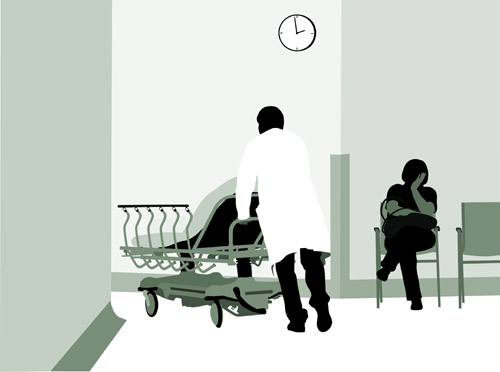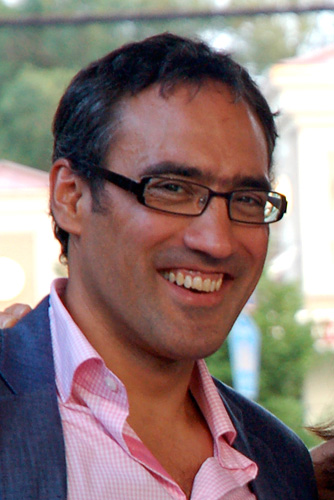 BY JOE ROJAS-BURKE | OB BLOGGER
BY JOE ROJAS-BURKE | OB BLOGGER
An economic study of emergency room utilization in Oregon set off a thundering media stampede earlier this month. I was struck by the cut-and-paste sameness of much of the reporting and how awfully little it had to say about the untreated wound that is causing all the pain: the hole in our healthcare system where a robust primary care infrastructure should be.
 BY JOE ROJAS-BURKE | OB BLOGGER
BY JOE ROJAS-BURKE | OB BLOGGER
Studies from the dismal science don’t often make big headlines, but an economic study of emergency room utilization in Oregon set off a thundering media stampede earlier this month:
“Obamacare Medicaid Expansion to Worsen Hospital ER Burden,” the New York Times intoned.
“Medicaid expansion under ObamaCare will lead to more emergency room visits,” Fox News declared.
“Obamacare Medicaid Expansion to Worsen Hospital ER Burden,” Bloomberg BusinessWeek chimed in.
And so on, and so on, and so on. Given the volume of coverage, I was struck by the cut-and-paste sameness of much of the reporting and how awfully little it had to say about the untreated wound that is causing all the pain: the hole in our healthcare system where a robust primary care infrastructure should be.
First, a bit of background. The economists who carried out the research took advantage of a “natural experiment” Oregon officials unwittingly set in motion in 2008 when they used a lottery to decide who among tens of thousands of uninsured, poverty-level adults seeking health care would be enrolled in Medicaid. As with the intentional randomization of volunteers in a controlled clinical trial, the lottery made it possible to rigorously test the effects of Medicaid coverage by comparing those who gained coverage and those who did not.
The table below summarizes the key findings of the new study, co-authored by Sarah Taubman at the National Bureau of Economic Research in Cambridge, Mass., Bill Wright at the Providence Center for Outcomes Research and Education in Portland, and three others. It shows the rate of emergency room visits among a group of mostly uninsured adults over an 18-month period, and how the visit rate increased among those who gained Medicaid coverage for at least part of those 18 months.
Average number of visits per 100 people not covered by Medicaid | Average increase in number of visits with Medicaid Coverage | ||
Needs immediate ER care & not preventable | 21 | 5 | |
Needs immediate ER care but preventable | 7 | 4 | |
Needs immediate care but primary care treatable | 34 | 18 | |
Does not need immediate care | 20 | 12 | |
Unclassified | 20 | 6 | |
Note how heavily the uninsured women and men relied on the emergency room during the 18-months of the study. There were 102 visits to the ER for every 100 people in this “control” group with no Medicaid coverage. Among those who gained Medicaid coverage, ER use averaged 143 visits per 100 people over 18 months, and most visits required some form of immediate care, although usually not from an emergency trauma center.
How did the herd of reporters explain this data? The Associated Press report was typical: “A new study has found that previously uninsured people enrolled recently in Medicaid went to the emergency room 40 percent more frequently than others.”
And media outlets all seemed to agree that this finding was unexpected and had uncovered a new challenge for Obamacare. There’s no doubt that it will be challenging for hospitals and health professionals to meet the demand for care as millions of uninsured Americans gain coverage under the Affordable Care Act. But that was clear before the law was enacted in 2010, by which time experts were already warning that universal coverage might well increase the number of frequent ED users because of the shortage of primary care providers.
“Visiting an ED with a non-urgent problem should not be labeled inappropriate if treatment cannot be secured at an alternative location,” Dr. Gary Young and colleagues pointed out back in 1996 in a paper in the Journal of the American Medical Association. Access is worst for Medicaid patients because many doctors deem the payments too paltry and the rules and paperwork too much of a hassle.
In a clever experiment conducted more than 10 years ago, Dr. Brent Asplin, an emergency medicine physician in St. Paul, Minn., ascertained what it’s like trying to get an appointment for a really urgent medical problem if you are poor and insured by Medicaid. Research assistants posing as patients called 499 randomly selected doctors’ offices and clinics in 9 cities and said they’d just been to a hospital emergency room and needed an urgent follow-up appointment for one of three alarming conditions: possible ectopic pregnancy, pneumonia, or out-of-control high blood pressure. The research assistants called each clinic twice using the same story but different insurance status.
Overall chances of getting an appointment within a week were pretty dismal: less than 50 percent. Callers who claimed to have private insurance had the best luck, but it wasn’t so great. Just 64 percent secured appointments. But that was nearly double the 34 percent success rate of Medicaid callers. In two cities, Denver, Colo., and Dallas, Texas, fewer than one in ten Medicaid callers succeeded in getting a timely visit.
Is it any wonder, then, that the poverty-level women and men covered by Medicaid, many of them dealing with multiple chronic health problems, have come to rely heavily on hospital emergency rooms that legally can’t turn patients away?
The point I’m getting to is this: Crowded ERs are merely a symptom of a deeper and more systemic failure of the U.S. health care industry that is hurting everyone, not just the poor.
People with private health insurance, in fact, make up a larger share of the people seeking non-emergency care in the ER. (People with private insurance account for about 24 percent of all non-urgent visits to the ER, while Medicaid enrollees account for a little under 23 percent and the uninsured for a little more than 17 percent, according to my calculations from data in the latest National Hospital Ambulatory Medical Care Survey.)
Even those of us with private insurance routinely run into barriers trying to get timely care from a doctor’s office – and resort to seeking care in a crowded ER out of desperation.
Studies going back to the 90s make that very clear. In a 2007 survey by the Commonwealth Fund, one-fifth of Americans reported difficulty contacting their primary care provider by telephone, and less than half reported that they could get a same-day or next-day appointment when sick or needing care. More than two-thirds said it was somewhat or very difficult to get care on nights, weekends or holidays without going to a hospital emergency room. And 15 percent said they had gone to the ER for a problem that could have been treated by regular doctor if available. On measures of access, the U.S. ranks worse than most other wealthy countries.
It’s no mystery what needs to be done to boost the performance of the U.S. health care system. We need to invest more in building a base of primary care practices capable of meeting the real needs of patients. The Affordable Care Act took a few steps in that direction. The law directed $12.5 billion to expand the capacity of Federally Qualified Health Centers the National Health Service Corps. And it boosts Medicaid pay rates to primary care doctors, but only through the end of 2014.
Oregon is also trying to strengthen primary care. The new Coordinated Care Organizations are developing alternative payment models that are supposed to shift more money to primary care providers who achieve quality goals, such as helping people avoid hospitalizations. But when I talked to several primary care doctors in Oregon last summer, they all told me that the persistence of fee-for-service reimbursement is holding back progress.
The transition will require dismantling an entrenched financing system that pays a lot more for doing high-tech services than keeping people healthy with timely, well-coordinated preventive care.
Joe Rojas-Burke blogs on science and health care for Oregon Business. 

 BY JOE ROJAS-BURKE | OB BLOGGER
BY JOE ROJAS-BURKE | OB BLOGGER